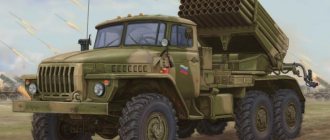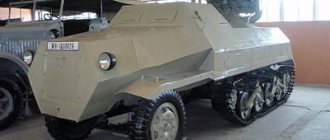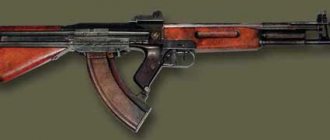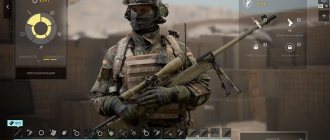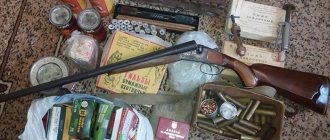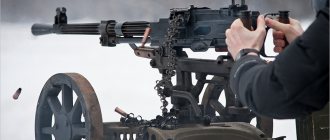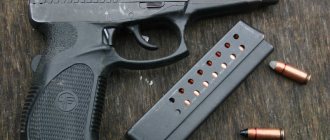Development
The BM-21 Grad and 9K57 Uragan in service did not suit the Soviet military with their short firing range. At the same time, firing unguided rockets at long distances was practically impossible due to a sharp drop in accuracy.
American colleagues, when creating MLRS, faced the same problem and limited the firing range to 40 kilometers.
Domestic designers were tasked with developing NURS capable of accurately hitting targets remote from the launcher. The way out was adjustable projectiles, which during flight adhere to the desired trajectory by turning off the nozzles.
On December 16, 1976, experimental design work began at the SPLAV enterprise to create a new multiple launch rocket system that meets the requirements of the army. They were conducted under the leadership of Ganichev, which was later taken over by G.A. Denezhkin. The testing schedule was so tight that Denezhkin was at the test site at the time of the birth of the child.
Almost on the New Year holidays of 1982, the Smerch MLRS passed state tests, after which, on November 19, 1987, it was put into service.
Notes
- 300-mm combat vehicle 9A52-2 “Smerch” (unspecified)
(inaccessible link). PJSC Motovilikha Plants. Retrieved September 19, 2014. Archived February 21, 2014. - Monstrous “Tornado” after “Smerch”: Russian MLRS are capable of turning 67 hectares into desert, Zvezda TV Channel
(April 17, 2016). Retrieved March 2, 2020. - ↑ 12
The Tornado-S system will receive a GLONASS-guided missile. Retrieved March 2, 2020. - ↑ 1 2
Military Balance 2017
(unspecified)
. IISS. - “Splav” created a drone embedded in the Smerch MLRS missile (Russian), TASS
. Retrieved March 2, 2020. - A drone built into the Smerch MLRS missile was created in the Russian Federation, Zvezda TV Channel
(February 28, 2017). Retrieved March 2, 2020. - Vladimir Tuchkov.
MLRS "Smerch": instant "cleaning" on an area of 67 hectares (Russian).
Free Press
(November 19, 2014). Retrieved March 14, 2020. - IDEX 2009:Chinese Multiple Rocket Launcher System AR1A 300 mm from Norinco Archived copy of March 7, 2011 on the Wayback Machine Asian Defense.
- Such destructive elements are also used in the RBK-500 aviation bomb cluster
- 300-mm 9M55K1 rocket with self-aiming combat elements (unspecified)
(inaccessible link). Retrieved January 5, 2010. Archived July 25, 2012. - rbase.new-factoria.ru
- ↑ 1 2 3 4
MLRS "Tornado-S" will go into production in 2020
(unspecified)
(inaccessible link). Retrieved September 24, 2020. Archived September 25, 2020. - 300 mm 9M55K5 rocket (undefined)
. Information and news system “Rocketry”. Retrieved February 17, 2013. Archived March 9, 2013. - at an angle of 30° from the normal to the armor from a distance of 100 m
- The new Russian drone "Grom" will receive a turbojet engine (unspecified)
. - The Military Balance 2020. - P. 180.
- The Military Balance 2020, p.184
- The Military Balance 2020. - P. 320.
- The Military Balance 2020. - P. 183.
- The Military Balance 2020. - P. 416.
- The Saakashvili regime restored its military potential in two years - TsAMTO » IA OSinform
- The Military Balance 2020. - P. 251.
- The Military Balance 2020. - P. 185.
- “Smerch” is rushing from Russia: China and India may receive its production technologies - Military parity
- The Military Balance 2020. - P. 339.
- The Military Balance 2020. - P. 357.
- Geography of distribution (Russian) (inaccessible link). JSC "Motovilikha Plants" Retrieved October 25, 2011. Archived January 12, 2012.
- 2002-01 Belarus on Arms Market in 2001 - Minus (unspecified)
(inaccessible link). Retrieved August 18, 2011. Archived December 13, 2014. - “Smerch” (9K58), 300-mm multiple launch rocket system - WEAPONS OF RUSSIA, Catalog of weapons, military and special equipment (unspecified)
(inaccessible link). Retrieved August 16, 2011. Archived August 9, 2011. - The Military Balance 2020. - P. 190.
- The Military Balance 2020. - P. 354.
- The Military Balance 2020. - P. 208.
- The Military Balance 2020. - P. 205.
- World arms trade, No. 1 2010. TsAMTO
- A. Khramchikhin.
China versus Russia. Victory will not be ours: [Russian] // Popular mechanics. — 2010. — February. - pp. 84-89. - Glazunov O.N.
Chapter 3. Secret operations of the PRC secret services in Russia // Chinese threat. - Moscow: Eksmo: Algorithm, 2010. - P. 167-169. — 256 p. — 3000 copies. — ISBN 978-5-699-40601-2. - Yuri Borodin.
Guardsmen - and that says it all
(undefined)
. Red Star (June 25, 2010). Retrieved May 31, 2020. - ↑ 1 2 3 Gurov S.V.
Multiple launch rocket system 9K58 “Smerch”
(unspecified)
. rbase.new-factoria.ru. Retrieved May 31, 2020. - Ukraine: Widespread use of cluster munitions (undefined)
. Human Rights Watch (20 October 2014). - Jonathan Ferguson & NR Jenzen-Jones.
Raising Red Flags:An Examination of Arms & Munitions in the Ongoing Conflict in Ukraine
(unspecified)
. Armament Research Services Pty. Ltd. (November 2014). - Spot report by the OSCE Special Monitoring Mission to Ukraine (SMM), 3 February 2020: Civilians killed and wounded in strike with cluster munitions in Izvestkova Street in Luhansk city (unspecified)
. OSCE. Retrieved February 4, 2020. - Spot report by the OSCE Special Monitoring Mission to Ukraine (SMM): Shelling in Kramatorsk, 10 February 2020 (English), OSCE (10 February 2015). Retrieved February 15, 2020.
- Evgeny Poddubny.
"Desert Falcons" will liberate Palmyra
(undefined)
. Russia-24 (March 20, 2016). Retrieved May 31, 2020. - Alexey Ramm.
At the border, the Turks walk gloomily
(undefined)
. "Military-Industrial Courier" (February 10, 2016). Retrieved May 31, 2020. - 300-mm combat vehicle 9A52-2 “Smerch” - Motovilikha. (unspecified)
(inaccessible link). Retrieved February 11, 2014. Archived February 21, 2014. - Armament of the SV MLRS Smerch
- MLRS "Smerch" and "Tornado-S" will receive guided missiles, 11.21.2015 MIA "Russia Today".
- Tornado-S missiles will receive GLONASS, 02/10/2017 OJSC "TRK RF AF "ZVEZDA"".
- “Tornado” will hit GLONASS signals, 02/08/2017 Alexey Ramm, Egor Sozaev-Guryev. "Newspaper Izvestia".
- Mikhail Vannakh
200 miles to the very point! // Popular mechanics. - 2020. - No. 5. - P. 96-101. — URL: https://www.popmech.ru/magazine/2017/175-issue/ - Top 10 main events in the Russian army in 2020, 01/01/2017 Mikhail Rychagov, Kirill Yablochkin. JSC "TRK AF RF "ZVEZDA"".
- "Tornado-S" is already in service, "Warspot".
- "Tornados", "Tornadoes" and "Hurricanes" "rage" in the Astrakhan region, 11/18/2016 JSC "TRK RF AF "STAR"".
- Gurov, 2010.
Footnotes
Design
The impressive-looking combat vehicle, which carries a launcher, was created at the Minsk Automobile Plant in Belarus. Initially it was chassis 79111, later the MAZ-543M and MAZ-543A chassis were used. Thanks to the 8x8 wheel arrangement and 525 hp diesel engine. each of them is characterized by high cross-country ability.
The launcher is a package consisting of 12 tubular guides located on a rotating base. To aim at the target, the installation moves vertically by electric drive in the range from 0° to +55°, horizontally – 30° to the left and the same amount to the right.
For stability during firing, an interesting technical solution was used, when hydraulic supports, mounted only between the third and fourth axles, extend and hang out the rear of the combat vehicle.
In addition to the combat vehicle, the Smerch complex includes:
- transport-charging machine;
- radio direction-finding complex;
- machine with topographic equipment.
The transport-loading vehicle is built on a similar combat chassis, equipped with a crane and carries 12 missiles.
Combat vehicle 9A52-2 on the chassis of a MAZ-543A vehicle
| Specifications | |
| Chassis | MAZ-543A |
| Number of guides, pcs | 12 |
| Weight of charged BM with calculation, kg | 43700 |
| Maximum driving speed with full load on paved roads, km/h | 60 |
| Fuel range, km | 850 |
| Dimensions in stowed position, mm: - length - width - height | 12100 3050 3050 |
| Combat crew, people | 4 |
Armament
The main feature of the Smerch MLRS was its 300 mm caliber projectiles with a flight control system. The electronic-time device transmits signals to the control unit, which, using gas-dynamic rudders, constantly adjusts the projectile’s flight path. Additionally, stabilization is achieved through promotion.
The designers managed to achieve accuracy in which the deviation of the NURS was no more than 0.21% of the firing range. When fired at maximum range, the spread is only 150 meters.
The NURS engines are solid fuel, and the warhead can be either monoblock or split, carrying 72 combat elements. Projectile length 7.5 meters, weight 800 kg.
Various warheads are used, for example, high-explosive fragmentation, cassette, thermobaric. It is also possible to remotely mine the surface using shells with mines. The latest development is an unmanned reconnaissance vehicle, launched inside a projectile and deployed the moment it is over the target.
A driving combat vehicle turns into a combat position in just 3 minutes, a salvo of 12 shells takes another 38 seconds, and another minute is required to turn and leave the position from which the shooting was conducted. Charging is carried out using a crane on a transport-charging machine and takes approximately 20 minutes.
Transport-charging machine 9T234-2T
| Specifications | |
| Chassis | TATRA 816 |
| Number of shells transported, pcs | 12 |
| TZM weight with shells and crew, kg | 36200 |
| Crane lifting capacity, kg | 850 |
| Maximum speed, km/h | 90 |
| Fuel range, km | 1000 |
| Dimensions in stowed position, mm: - length - width - height | 12660 3050 3535 |
| Calculation, persons | 3 |
Export and foreign analogues
In 1989, the 9K58 “Smerch” modification, created on the basis of the MAZ-543M, was adopted. At the same time, the firing distance was increased from 70 to 90 km, satellite systems began to be used for guidance, and the crew was reduced to 3 people.
In 2007, the public was shown the 9K58 Kama system based on the four-axle KamAZ-6350 with 6 guides instead of 12. The vehicle was designed for greater mobility with less weight and dimensions. Russia also expects to export them.
The main operators of the machine are Russia, Ukraine, Belarus, Azerbaijan, India and Kuwait. In total, the vehicle is in service with 15 countries.
A little about shells
It should not be assumed that Smerch shells are a banal high explosive charge. Currently, more than a dozen of their varieties are already in use, and new types are constantly being developed.
The most commonly used standard high-explosive projectile is the 9M55F. The head part is solid, the weight of the explosive does not exceed 100 kg. They are used to treat advanced enemy fortifications, to combat lodged infantry and destroy light armored vehicles on the march.
The 9M55K model was developed specifically for the destruction of enemy personnel. The head of each projectile contains 72 separable elements (2 kilograms each) with explosive and destructive elements. Just 10-12 such charges are enough to completely destroy a standard motorized infantry company.
On the contrary, the 9M55K1 projectile was developed specifically to combat armored vehicles (including heavy tanks). In its head there are five projectiles with automatic aiming. If the Smerch combat system is used in the role of a “tank hunter,” then a simultaneous salvo of just four vehicles is sufficient to completely destroy an entire tank company (!).
The order of combat use
As in all other cases, the use of this multiple rocket launcher system is fully subject to the special provisions of the Charter.
First, the command post of a brigade of MLRS vehicles must receive data about the enemy, as well as about his location. Based on the information obtained, calculations are made about the direction of the impact. The type of ammunition, the density of fire, and its adjustment depending on the conditions on the ground are selected. After this, all information is transmitted to the command post of the division that was selected to solve the corresponding combat mission.
After this, the command staff studies the received data, correlating them with the available resources. Considering that the Smerch is a reactive system, its operation requires a fairly open and spacious position, since in heavily wooded or mountainous terrain, launching projectiles may be unsafe for the operators themselves.
The information is then transmitted to the commanders of the units who are responsible for striking enemy positions.
The transmitted data is processed on the computing facilities of the Smerch battery (six machines). Everything happens automatically, since the military has repeatedly found out that this approach dramatically increases the effectiveness of fire. In addition, this reduces the time required to bring the complex into combat position by hundreds of times.
Immediately after this, the unit commanders wait for the order to open fire on enemy positions.
That's what "Smerch" is. This MLRS has proven to be a surprisingly effective and reliable weapon, and therefore is in service today with dozens of countries around the world. Modernized versions of it are constantly supplied to our troops today.
Firing
The total weight of each projectile, regardless of its type, is 800 kilograms, with the warhead itself accounting for 280 kilograms. The standard approach angle to the target is from 30 to 60 degrees, but some types of projectiles can be configured to dive at an angle of 90 degrees. Such “meteorites” pierce heavy armored vehicles right through.
Even if there is no penetration, the explosion of 280 kg of explosive in the immediate vicinity of the tank is certain death from severe concussion for its crew, and the vehicle will receive such damage that without repair it will not even move. Due to this, the BM-30 “Smerch” or the MLRS “Tornado” (a modern replica) can be used as a means of stopping tank columns on the march. Something similar happened in Georgia in 2008, when Grads covered a group of Georgian tanks breaking through to the positions of our troops.
Characteristics of a tornado, tornado
Types of tornadoes
Tornadoes can vary in shape. They come in the form of a cone, a barrel, even a glass. We also noticed tornadoes in the form of a horn, an hourglass and cords in constant motion. Despite the variety of shapes, tornadoes usually look like a funnel that absorbs everything in its path.
Interesting fact : sometimes tornadoes can carry away a wide variety of objects. After which the famous rains of frogs, fish and insects appear.
Duration of existence
- A tornado can last for a few minutes or for hours.
- The pressure in the center and along the peripheries varies by up to 200 mb.
- The tornado moves extremely quickly, reaching speeds of up to 1000 km/h.
- Despite the randomness of its occurrence, the phenomenon can move along certain lines. In the north of the planet - counterclockwise, and in the south - along it.
- The tornado destroys territories located in a diameter equal to three kilometers.
- A tornado can be of various colors, which are determined taking into account the location of the Sun, humidity and lighting of nearby areas.
Tornadoes that appear in front of the Sun have a darker color, while if the Sun is hidden behind the observer, the tornado looks much lighter. In humid air, the outline of the disaster is much clearer. The most dangerous phenomena are those that occur in dry climates, since they may not be immediately noticed. Only when some objects get caught in the vortices can it be seen, but then it is already too late. Sand and rain storms pose an even greater danger. In heavy rains they are also difficult to see.
System composition
- Actually the 9K58 combat vehicle itself.
- Machine for transporting and feeding shells 9T234-2.
- A set of ammunition, which, depending on the task at hand, can vary greatly.
- Visual aids and staff training tools.
- Kit 9F819, which includes both specialized tools for repairs and tools for setting up high-precision equipment.
- Automated fire control system "Slepok-1".
- A machine for conducting topographic surveys of the area, the results of which are used for reference to the relief and especially prominent parts of the relief.
- Radio direction finding unit 1B44. It allows you to timely detect the enemy’s progress, recording ongoing radio communications, including encrypted ones.
The launcher itself consists of a chassis with tubular guides and a MAZ-543 all-terrain vehicle. The artillery complex is mounted in the stern, and in front there is a driver's cabin and crew seats, equipped, among other things, with means for aiming and firing. MLRS can be successfully used in a wide variety of climatic and meteorological conditions, at ambient temperatures from +50 to -50 degrees Celsius.
Other mechanisms
The rotating part of the machine is the most complex in its design. Its design includes a rocker, rotating, lifting and compensating mechanisms, as well as a manual guidance mechanism and a guidance operator’s workplace. Locking mechanisms are important (including for the pumping hydraulics), on which shooting accuracy largely depends. The compensation mechanism includes a pair of torsion bars and fastening parts.
In general, the Smerch MLRS, a photo of which is in the article, is subject to catastrophic overloads during salvo fire, so not only the shooting accuracy, but also the safety of the entire crew depends on the state of the compensatory mechanisms.
In normal mode, a hydroelectric drive is used to guide the guides to the target. If the mechanism fails or is damaged, there is a manual drive. When moving, all rotating parts are blocked by locking blocks. In addition, the hydraulic lock of the rocking chair greatly relieves the entire complex when performing shooting.
The sighting system includes the proven and proven sight D726-45. The goniometer device is the usual standard PG-1M gun panorama.
